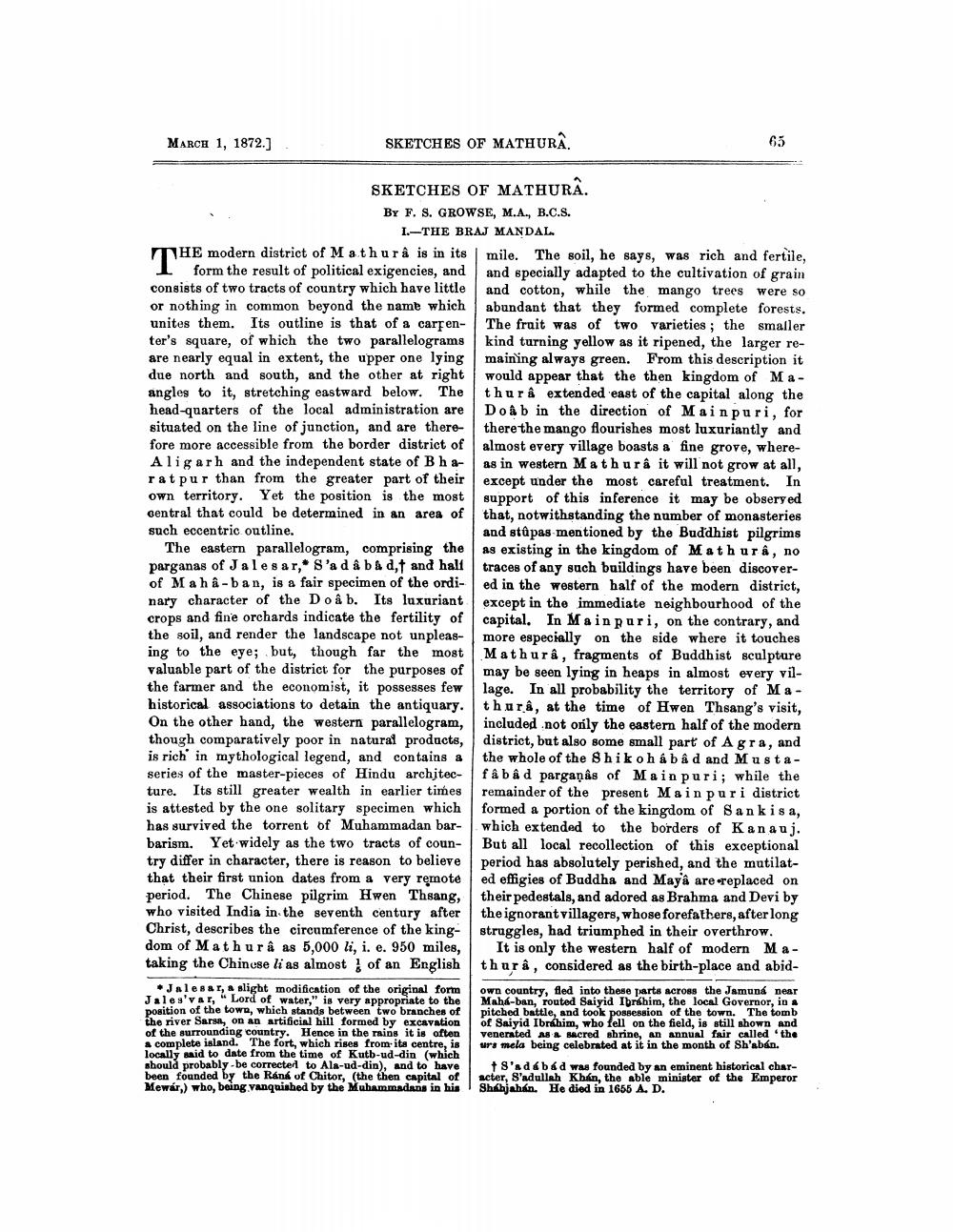________________
MARCH 1, 1872.]
SKETCHES OF MATHURA.
SKETCHES OF MATHURA. BY F. S. GROWSE, M.A., B.C.S.
1.—THE BRAJ MANDAL THE modern district of Mathura is in its mile. The soil, he says, was rich and fertile,
1 form the result of political exigencies, and and specially adapted to the cultivation of grain consists of two tracts of country which have little and cotton, while the mango trees were so or nothing in common beyond the name which abundant that they formed complete forests. unites them. Its outline is that of a carpen- The fruit was of two varieties; the smaller ter's square, of which the two parallelograms kind turning yellow as it ripened, the larger reare nearly equal in extent, the upper one lying maining always green. From this description it due north and south, and the other at right would appear that the then kingdom of Maangles to it, stretching eastward below. The thura extended east of the capital along the head-quarters of the local administration are Doâ b in the direction of Mainpuri, for situated on the line of junction, and are there there the mango flourishes most luxuriantly and fore more accessible from the border district of almost every village boasts a fine grove, whereAligarh and the independent state of Bha- as in western Mathurâ it will not grow at all, ratpur than from the greater part of their except under the most careful treatment. In own territory. Yet the position is the most support of this inference it may be observed central that could be determined in an area of that, notwithstanding the number of monasteries such eccentric outline.
and stūpas mentioned by the Buddhist pilgrims The eastern parallelogram, comprising the as existing in the kingdom of Mathura, no parganas of Jalesar,* S'ad a b & d, and half traces of any such buildings have been discoverof Maha-ban, is a fair specimen of the ordi- ed in the western half of the modern district, nary character of the Do & b. Its luxuriant
except in the immediate neighbourhood of the crops and fine orchards indicate the fertility of capital. In Mainpuri, on the contrary, and the soil, and render the landscape not unpleas- more especially on the side where it touches ing to the eye; but, though far the most Mathuri, fragments of Buddhist sculpture valuable part of the district for the purposes of may be seen lying in heaps in almost every vilthe farmer and the economist, it possesses few lage. In all probability the territory of Mahistorical associations to detain the antiquary. thurâ, at the time of Hwen Thsang's visit, On the other hand, the western parallelogram, included not only the eastern half of the modern though comparatively poor in natural products, district, but also some small part of Agra, and is rich in mythological legend, and contains a the whole of the shikoh á bâd and Mustaseries of the master-pieces of Hindu architec- fâbâd parganâs of Mainpuri; while the ture. Its still greater wealth in earlier times remainder of the present Mainpuri district is attested by the one solitary specimen which formed a portion of the kingdom of Sankis a, has survived the torrent of Muhammadan bar- which extended to the borders of Kanauj. barism. Yet widely as the two tracts of coun- But all local recollection of this exceptional try differ in character, there is reason to believe period has absolutely perished, and the mutilatthat their first union dates from a very remote ed effigies of Buddha and Mayà are replaced on period. The Chinese pilgrim Hwen Thsang, their pedestals, and adored as Brahma and Devi by who visited India in the seventh century after the ignorant villagers, whose forefathers, after long Christ, describes the circumference of the king- struggles, had triumphed in their overthrow. dom of Mathurâ as 5,000 li, i. e. 950 miles, It is only the western half of modern Mataking the Chinose li as almost of an English thurâ, considered as the birth-place and abid
Julesar, a slight modification of the original form own country, fled into these parts across the Jamuns near Jales'yar," Lord of water," is very appropriate to the Mahá-ban, routod Saiyid Ibrahim, the local Governor, in position of the town, which stands between two branches of pitched battle, and took possession of the town. The tomb the river Sarsa, on an artificial hill formed by excavation of Saiyid Ibrahim, who fell on the field, is still shown and of the surrounding country. Hence in the rains it is often venerated as & sacred shrine, an annual fair called the
complete island. The fort, which rises from its centre, is urs mela being celebrated at it in the month of Sh'abán. locally said to date from the time of Kutb-ud-din (which should probably be corrected to Ala-ud-din), and to have S'adabad was founded by an eminent historical charbeen founded by the Rank of Chitor, (the then capital of acter, S'adullah Khán, the able minister of the Emperor Mewár) who, boing vanquished by the Muhammadana in his Shahjahan. He died in 1655 A. D.




